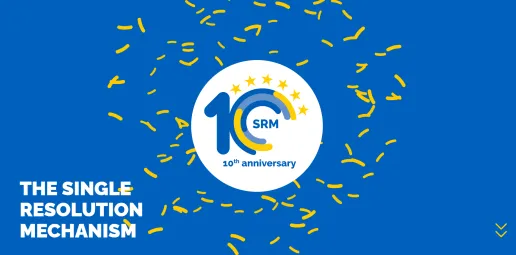The Single Resolution Mechanism is made up of the Single Resolution Board and the National Resolution Authorities in Eurozone countries and Bulgaria. It protects financial stability and the taxpayer by planning for and managing bank failures. The SRM is the second pillar of the Banking Union, providing centralised and independent decision-making on bank resolution, ensuring that the public interest and critical economic functions are protected.
The SRM provides strong, centralised and independent decision-making ensures that resolution decisions across participating Member States of the Banking Union are taken effectively and quickly, avoiding uncoordinated action, minimising negative impact on financial stability, limiting the need for public financial support and ensuring a level playing field.
SRM 10th anniversary
Single Resolution Mechanism 10th Anniversary
SRM 10th Anniversary Conference
Interactive story: 10 years of safeguarding financial stability in the EU
Navigate through the interactive scrolling story, a visual narrative tracing the milestones, challenges and achievements of the Single Resolution Mechanism (SRM).
The story traces the Single Resolution Mechanism’s journey highlighting key milestones such as the first resolutions, the growth of the Single Resolution Fund, and progress on MREL. It shows how the SRM has strengthened Europe’s banking system through real cases and looks ahead to new challenges under SRM Vision 2028.

A little bit of history….
The financial crisis that unfolded in 2008 showed that authorities lacked the tools and preparation to wind down banks in an orderly manner. Ending the so-called ‘too big to fail’ problem and the undesirable feedback loop between banks and governments went to the top of the political agenda of the G20 group of nations. The G20 endorsed the Key Attributes for Effective Resolution Regimes of the Financial Stability Board (FSB) in October 2011 and annexes were added in October 2014.
This international reference document requires member jurisdictions to establish frameworks for the orderly wind down – referred to as ‘resolution’ – of large, systemically important financial institutions.
The EU’s response was to establish an orderly cross-border resolution mechanism via the Bank Recovery and Resolution Directive (BRRD), which provides resolution authorities with comprehensive powers and resolution tools to intervene when a bank meets the conditions for resolution. Resolution authorities have to prepare resolution plans detailing how a bank will be resolved, in a way that achieves the resolution objectives, while ensuring taxpayers avoid carrying the burden, as was the case in the recent crisis.
The BRRD, the Deposit Guarantee Scheme Directive (DGSD), the European Commission (EC) Delegated Acts, prepared on the basis of Technical Standards drafted by the European Banking Authority (EBA), and the EBA’s Guidelines, form a single rulebook for the EU for resolution planning and execution and the application of Deposit Guarantee Schemes (DGSs) (see the Annex for a current list of EC Delegated Acts, EBA Technical Standards, and EBA Guidelines).